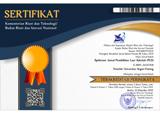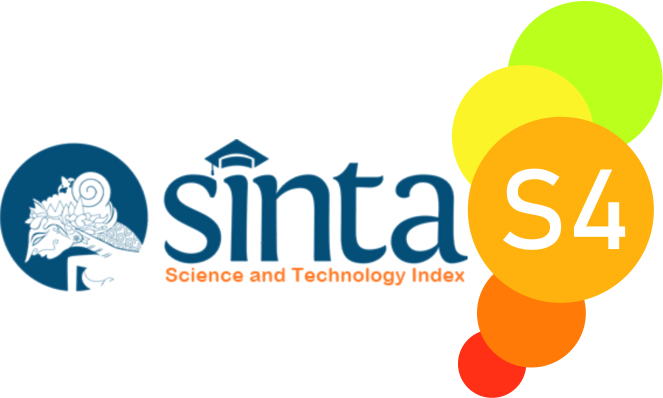The Relationship Between Training Methods And Student Activity in Extracurricular Arts SMKN 5 Padang
 ), Jamaris Jamaris(2),
), Jamaris Jamaris(2), (1) Universitas Negeri Padang
(2) Universitas Negeri Padang
 Corresponding Author
Corresponding Author
DOI : https://doi.org/10.24036/spektrumpls.v12i1.127283
Full Text:
 Language : en
Language : en
Abstract
This research was hampered by the low student activity on extracurricular arts, which was allegedly due to the inadequacy of the practice methods used. The aim is to look at the methods of practice, student activity and see the relationship between the method of practice and student activity on extracurricular arts. The research method uses a quantitative approach to the type of correlational research. The population of this research is all that follows the activity with sampling using the Cluster Random Sampling technique. Data gathering techniques using lifting. Data analysis techniques using percentage formula and Product Moment formula.The results of the study showed that; the methods of training used by trainers in extracurricular still belong to the less appropriate category; student activity also belonged to low; and there was a significant relationship between the method of training and student activity in the extra-curricular arts.Since the extracurricular activities of the arts are very beneficial to the students, there is a need for the efforts of the school to pay attention and enhance the construction of such extracursual activities. It is recommended to the extra-curricular art trainers, to increase and maximize the use of methods of training in extracural activities so as to a high level of activity.
References
Agustina, I. O., Juliantika, J., Saputri, S. A., & Putri, S. R. (2023). Peran Kegiatan Ekstrakurikuler dalam Pembinaan dan Pengembangan Siswa Sekolah Dasar. Jurnal Bintang Pendidikan Indonesia, 1(4).
Aziz, M., Ashshiddiqi, H., & Mahariah, M. (2020). Ektrakurikuler PAI (Pendidikan Agama Islam) Dari Membaca Alquran sampai Menulis Kaligrafi. Media Madani.
Dari, S. W., & Setiawati, S. (2022). The Relationship Of The Effectiveness On Communication In Learning And Active Participation Of Trainee At The West Sumatra Agricultural Training And Extension Center. SPEKTRUM Jurnal Pendidikan Luar Sekolah, 10(1).
Esilvita, E. (2023). Develolopment of Learning Strategi-Based Training Programs. KOLOKIUM Jurnal Pendidikan Luar Sekolah, 11(3).
Febriani, W., & Jamaris, J. (2022). The Relationship Between the Tutor’s Learning Method with the Activity of the Learners Package C in PKBM Pratama, Pancung Soal District, Pesisir Selatan. SPEKTRUM: Jurnal Pendidikan Luar Sekolah (PLS), 10(2).
Hamdi, A. S. (2015). Metode Penelitian Kuantitatif Aplikasi dalam Pendidikan. Deepublish.
Ismaniar, I., Deona, S., & Land, K. S. (2023). STEAM Approach with Loose Parts Learning Materials in the Early Childhood Education. Pedagogi: Jurnal Ilmu Pendidikan, 23(1).
Istarani, I. (2011). Model Problem Centered Learning: Model Pembelajaran Inovatif. Media Prasada.
Jamaris, J. (2016). Pendampingan Luar Sekolah dan Kompetensi Pendamping Pendidikan Masyarakat Desa. Seminar Nasional Jurusan Pendiidkan Luar Sekolah.
Mufaidah, R. S., & Lukitaningsih, R. (2014). The Implementation of Extracurricular Activities in Guidance and Counseling According to Curriculum 2013 at Senior High School 2 Tuban. Jurnal BK, 04(03).
Nopaldi, A., & Setiawati, S. (2018). Hubungan antara Motivasi Belajar dengan Minat Belajar Warga Binaan pada Keterampilan Menjahit di Panti Sosial Karya Wanita Andam Dewi Solok. Spektrum: Jurnal Pendidikan Luar Sekolah (PLS), 1(4). https://doi.org/10.24036/spektrumpls.v1i4.101463
Sanjaya, W. (2013). Strategi Pembelajaran Berorientasi Standar Proses Pendidikan. Kencana.
Sari, Y. N. (2018). Pengaruh Penerapan Model Pembelajaran Means Ends Analysis Menggunakan Media Video Terhadap Keaktifan Belajar Peserta Didik Pada Mata Pelajaran Ekonomi di SMA Negeri 3 Pagar Alam. Jurnal PROFIT: Kajian Pendidikan Ekonomi Dan Ilmu Ekonomi, 5(1).
Slameto. (2015). Belajar dan Faktor-faktor yang Mempengaruhinya. Rineka Cipta.
Sudjana, D. (2004). Pendidikan Non Formal. Falah Production.
Sudjana, N. (2017). Dasar-dasar Proses Belajar Mengajar. Sinar Baru.
Sumiati, S. (2013). Metode Pembelajaran. Wacana Prima.
Sunarti, V., Iswari, M., Putri, L. D., & Handrianto, C. (2023). A Technological Approach for Examining the Tutor Performance, Study Materials, Learning Methods, Management of Learning Environment and Students` Students`Learning Motivation. Tuijin Jishu/Journal of Propulsion Technology, 44(2).
Usman, M. U. (2012). Menjadi Guru Profesional. Sinar Baru Algesindo.
Wibowo, N. (2016). Upaya Peningkatan Keaktifan Siswa Melalui Pembelajaran Berdasarkan Gaya Belajar di SMK Negeri 1 Saptosari. Elinvo (Electronics Informatics and Vocational Education), 1(2).
Yhunanda, Y., & Sholeh, M. (2020). Peran Kegiatan Ekrakurikuler dalam Upaya Meningkatkan Prestasi Siswa. Jurnal Inspirasi Manajemen Pendidikan, 08(04).
Zalfendi, Z., Neldi, N., & Rasyid, R. (2011). Strategi Pembelajaran. Sukabina Press.
Zulhadrizal, Z. (2023). Implementasion of Strategy-Based Training Learning. KOLOKIUM Jurnal Pendidikan Luar Sekolah, 11(3).
 Article Metrics
Article Metrics
 Abstract Views : 105 times
Abstract Views : 105 times
 PDF Downloaded : 29 times
PDF Downloaded : 29 times
Refbacks
- There are currently no refbacks.

This work is licensed under a Creative Commons Attribution-NonCommercial 4.0 International License.



